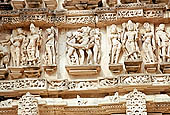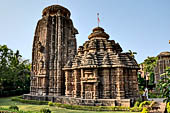|
|
| Hindu and Buddhist Architecture |
|
|
|
Traditionally referred to the Indian subcontinent, Hindu architecture actually spreads across Southeast Asia over Cambodia and Indonesia, where Indian architectural aesthetics amalgamate with indigenous cultures.

|
The Sun Temple of Konarak
|
The great majority of Indian monuments are religious buildings. The earliest bulidings are from the Buddhist period (IV century BC) when elaborate rock-cut caves start to appear, later replaced by stone buildings and brick stuctures of viharas (Buddhist monastery), chaityas (prayer halls) and stupas.
Later, in the Gupta Period (around 400 AD), the earliest Indian temples start to evolve from the simple unimpressive stone garba-griha to the Hindu Temple in its final form that followed in the mediaeval age (VII-X century).
After the Muslims invasion (XIII C.) most of the Hindu temples of the North were destructed and replaced by Islamic mosques. On the other side secular buildings start to appear and magnificent fortified complexes and palaces were built epitomizing the Mughal architecture.
Khajuraho |

|
Indian architecture appears like an indigenous art, borrowing little from foreign styles, and having no affinities with western arts. Unlike Christian churches or Muslim mosques, Hindu temples are the abode of the actual deity, shrouded in the deliberate mysterious darkness of the womb-like garbhagriha sourmounted by the mountain-like tower shikhara and glimpsed by the worshipper during the darshan (the ritual viewing). Pillared halls (mandapa) were added in later times.
Indian architecture does not know the true arch, vault or dome, which were common by the time in other parts of the world, with the result of narrow, restricted, dark inner spaces.
The characteristc curvilinear shikhara is a common sight in Northern Indian towns and villages and lot of them can still be seen in vartious state of conservation and artistic interest. Among the most interesting ones it is not possible not to mention the greatest temple sites of Khajuraho in central India, Bhubaneswar and Konark in Orissa, examples of the peak phase of Hindu Temple architecture.

|
Yoginis temple of Hirapur
|
The most striking feature of Hindu architecture are the external sculptures: temple surfaces are sometimes litterally covered of beautiful sculptures, often in bas-reliefs, in a way that rather than an architectural piece, the Hindu temple can be considered a mass scale sculpture. The sculptural motifs range from cult and mythical nattarive images to every-day life scenes, often providing interesting clues on religious and cultural life of medieval India, including the erotic scenes a feature which attracts frequent notice.
Temples of Bhubaneswar |

|
In spite of all the differences and distinctions, a set of fundamental principles unify Indian architecture. This fact becomes even more amazing when we see similar stylistic content in the distant Indo-Buddhist monuments from Burma to Java. In the immense temple compound of Angkor in Cambodia, stupendous examples of Khmer architecture, Hindu concepts have never been interpreted with more precision.

|
Hindu Temples of North India
|
|
Related Pages
-
-
-
-
-
-
|
|
|
 |
|



